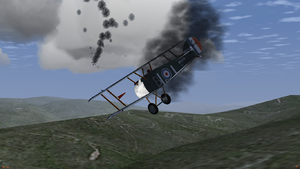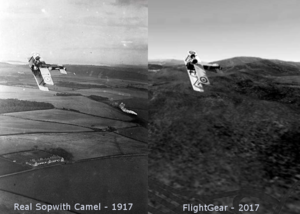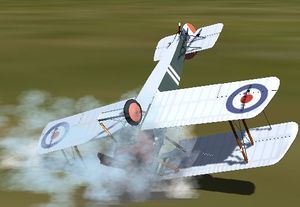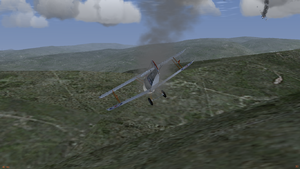Sopwith Camel (JSBSim)
 JSBSim Sopwith Camels in Bombable add-on | |
| Type | Historical aircraft, Fighter aircraft |
|---|---|
| Configuration | Biplane aircraft, Taildragger aircraft |
| Propulsion | Single-engine aircraft, Piston aircraft, Propeller aircraft |
| Manufacturer | Sopwith Aviation Company |
| Author(s) | AJ MacLeod, Vivian Meazza, Brent Hugh (Historically accurate JSBSim FDM & weapons, Bombable compatibility) |
| FDM | JSBSim |
| --aircraft= | sopwithCamel-JSBSim-Bombable |
| Status | Production |
| FDM |
|
| Systems |
|
| Cockpit |
|
| Model |
|
| Supports |
|
| Development | |
| Repository |
|
| Download |
|
| Forum |
|
| Wikipedia |
Sopwith Camel |
|
| |
The Sopwith Camel was a British First World War single-seat biplane fighter introduced on the Western Front in 1917.
This page is about the JSBSim version of the Sopwith Camel created for FlightGear and based on historical data and reports about aircraft performance and handling.
The aircraft features:
- An advanced JSBSim Flight Dynamics Model based on extensive historical research and testing to match historical performance data, handling characteristics, and capabilities
- Ground and water effects, friction, terrain bumpiness, shadows, dust
- Crash and damage effects
- Historically accurate weapons capabilities
- Extensive sound design
- Bombable compatible
Aircraft help
Keys and controls
| Key | Function |
|---|---|
| S | Start engine (OR: Click propeller/center of dash) |
| B | Blip switch - both magnetos OFF - blip and magnetos are the primary method for controlling engine power |
| { / } | Toggle left/right magneto switch. 4/9 and 5/9 power settings for left and right magneto alone, respectively. Magneto switches visible on dash at lower left. |
| ⇧ Shift+B | Toggle chocks (OR: click chocks/wheels with mouse) |
| U /⇧ Shift+U / Ctrl+U | Adjust pilot viewpoint up/down, select default pilot viewpoint |
| M /⇧ Shift+M | Adjust mixture (If manual mixture selected via menu Camel/Toggle Manual Mixture) |
| E | Fire guns |
| L | Change livery |
| N | Nudge aircraft forward (ie, when taxiing in the grass and stuck) |
- WwAaSsQq and mouse - In INSPECT AIRCRAFT VIEW: Move and look around (V /⇧ Shift+V to select this view; see View/View Options)
- Camel Menu - Repair/restore aircraft (must be on ground/stopped), hide pilot and cockpit clutter, more
Starting out
Press { and } once each - so that both L and R magneto switches are in upward position.
Check that Blip Switch (B key, visible button on Camel's joystick handle) is disengaged.
Check throttle set at 100% (on startup FlightGear often registers your throttle at 0% even though the slider may be at 100%; give it a jiggle to prevent underpowered takeoff).
Press and hold the S key for 0.5 seconds.
It may take several tries before the engine catches.
If you spawn in on the ground, chocks are in place. ⇧ Shift+B to remove.
Takeoff
Always take off directly INTO wind regardless of runway configuration.
Zoom view full out; steer via peripheral vision.
Easiest, most dependable way to take off: Full throttle, moderate back-pressure on stick to keep tail engaged w/ ground. Use rudder to steer (tail dragging on ground provides most control authority). 3-point lift-off @ 40-45 KTS (45-50 mph); immediately ease stick forward to avoid excessive climb, loss of airspeed, stall.
More advanced takeoff procedure usable under calm conditions: Gently lift tail @ 30-35 mph and continue rolling (or in ground effect) through 50-55 mph before lift-off.
Crashing on takeoff? Check wind and weather - many real Camel pilots crashed on take-off/landing with strong crosswind or tailwind.
Throttle, blip switch, and magnetos
Real Camel pilots used a combination of throttle, magneto settings, and the blip switch to achieve desired power settings.
Throttle provides a limited range of power settings.
The blip switch (B) disengages both magnetos and cuts power totally. Engaging either R or L brake (via keyboard, joystick, or rudder/pedals) also engages the blip switch. Releasing the brake (or releasing the B key) releases the blip switch.
Engaging only one magneto ({ or }) reduces engine power to just under half (L magneto) and just over half (R magneto).
This gives you 3 distinct power settings via magneto (L, R, or both) - you can fine-tune each of them with the throttle.
Note that L magneto ON/R magneto OFF + Blip switch gives you very fine low-power control, for example for approach and landing.
Negative G - Inverted flight
The Camel's fuel system requires gravity to feed fuel to the engine.
If you fly inverted or pull negative Gs, the engine will soon stop.
Once you return to upright flight, fuel will flow and the engine will start again.
Approach and landing
Land directly into wind regardless of runway layout.
Throttle FULL OPEN, L Magneto ON, R Magneto OFF.
Control engine power via Blip Switch (B); Engine is typically mostly OFF (via Blip) on approach.
Note relatively steep glide slope.
Sideslip as needed to control speed. Simply engaging ailerons may provide you with all the sideslip you need (adverse yaw).
On runout, hold tail firmly down to act as brake.
Unstable or ground loop on landing? Just add full power (R Magneto ON) and go around.
Guns and reloading
Guns have 400 rounds each, the maximum historical capacity of the Camel.
Fire with the E key or a joystick trigger linked to /controls/armament/trigger.
Reload guns: Use the Camel Menu - you must be on ground, stopped, engine off.
Miscellaneous
TAXIING: In windy conditions, use elevator to hold tail firmly down for better steering authority.
At high RPM, prop wash gives some rudder and elevator authority even at near stand-still. Use this plus the burst of power from Blip to help maneuver and taxi over bumps.
Don't forget N for nudge when you get stuck.
STALL: Push forward firmly on the stick, gain airspeed. Vigorously oppose any spin (rudder and ailerons). It may help to blip engine off, reducing torque and gyroscopic moment. You will lose ~500 ft altitude or more.
TRIM: Real Camels had no trim mechanism and were tail heavy with full fuel - nose heavy with low fuel. With full fuel, constant 10-20 lbs forward pressure on the stick was required to maintain level flight.
Be aware of natural nose-up attitude and potential for inadvertent climb and stall whenever flying with full fuel!
Extensive help, tips, historical documents and references in the DOCS folder.
Key speeds and technical data
- Approach speed 55 KTS (60-65 mph)
- Threshhold speed 48 KTS (55 mph)
- Touchdown speed: 40 KTS (45-50 mph)
- Stall speed 41 KTS (48 mph)
- Best Climb speed 55 KTS (60-65 mph) (all Indicated Air Speed/IAS)
- Top speeds:
- 115 mph @ 6500 ft
- 113 mph @ 10000 ft
- 106.5 mph @ 15000 ft (all True Air Speed/TAS)
- Climb to
- 6500 ft = 6 min 0 sec
- 10000 ft = 10 min 35 sec
- 15000 ft = 20 min 40 sec
- Service Ceiling: 19,600 ft
- Range: 217 miles
- Empty weight: 956 lb
- Fully Loaded weight: 1523 pounds
- Fuel: Main (pressure) tank 30 gallons; gravity tank 7 gallons; total 37 gallons.
- Castor Oil: 6.5 gallons.
- Engine: 130 HP Clerget 9B Rotary
- Armament: 2 synchronized 7.7mm Vickers machine guns
Related content
Wiki
- Sopwith Camel - The YASim version, with which the JSBSim version share aircraft model and many details.


